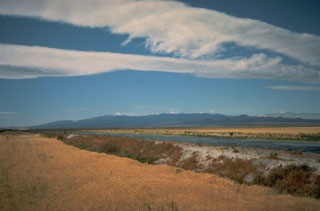Report on Medicine Lake (United States) — November 1988
Scientific Event Alert Network Bulletin, vol. 13, no. 11 (November 1988)
Managing Editor: Lindsay McClelland.
Medicine Lake (United States) Small seismic swarm
Please cite this report as:
Global Volcanism Program, 1988. Report on Medicine Lake (United States) (McClelland, L., ed.). Scientific Event Alert Network Bulletin, 13:11. Smithsonian Institution. https://doi.org/10.5479/si.GVP.SEAN198811-323020
Medicine Lake
United States
41.611°N, 121.554°W; summit elev. 2412 m
All times are local (unless otherwise noted)
Small events recorded late November-early December were attributed to freezing phenomena as winter came to N California. On 13 December at 2035, an M 1.9 earthquake, ~0.25 km SW of Medicine Lake glass flow, was recorded. During the next 75 minutes, nine events (M less than 1.9) were detected, followed by seven events on 14 December from 0121 to 0129. Seismicity was shallow (below 1 km) and had a high-frequency character. The 3-component station (LMD) is not currently operating.
Geological Summary. Medicine Lake is a large Pleistocene-to-Holocene, basaltic-to-rhyolitic shield volcano east of the main axis of the Cascade Range. Volcanism, similar in style to that of Newberry volcano in Oregon, began less than one million years ago. A roughly 7 x 12 km caldera truncating the summit contains a lake that gives the volcano its name. A series of young eruptions lasting a few hundred years began about 10,500 years before present (BP) and produced 5 km3 of basaltic lava. Nine Holocene eruptions clustered during three eruptive episodes at about 5000, 3000, and 1000 years ago produced a chemically varied group of basaltic lava flows from flank vents and silicic obsidian flows from vents within the caldera and on the upper flanks. The last eruption produced the massive Glass Mountain obsidian flow on the E flank about 900 years BP. Lava Beds National Monument on the N flank of Medicine Lake shield volcano contains hundreds of lava-tube caves displaying a variety of spectacular lava-flow features, most of which are found in the voluminous Mammoth Crater lava flow, which extends in several lobes up to 24 km from the vent.
Information Contacts: S. Walter, USGS Menlo Park.

